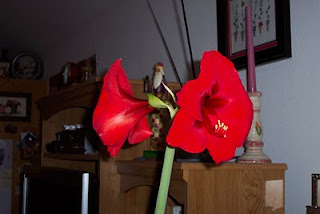
Rosa 'Trumpeter'
Very colorful rose bush. Found that it was introduced in 1977.
Is resistant to rust, black spot and mildew.
Rose breeders easily noticed the significance in crossing polyanthas together with hybrid teas, to produce roses which bloomed with the polyantha profusion, however with hybrid tea floral elegance and color variety. In 1909, the very first polyantha/hybrid tea combination, 'gruss an Aachen,' was produced, with features half way among each parent classes.
Since the bigger, more shaped flowers and hybrid-tea-like development routine divided these brand new roses from polyanthas and hybrid teas as well, a brand new class had been produced and called Floribunda, Latin for "many-flowering." Normal floribundas feature rigid shrubs, scaled-down and bushier compared to the typical hybrid tea yet much less thick and rambling versus typical polyantha.
The flowers in many cases are small compared to hybrid teas but they are carried in large sprays, offering an improved flower result inside the garden. Floribundas are found in every hybrid tea colors along with the vintage hybrid tea-shaped bloom, occasionally different from hybrid teas simply inside their cluster-flowering routine. Nowadays these are even now found in huge bedding techniques in public recreational areas and other alike places.
Grows best in Zones: 4, 5, 6, 7, 8, 9.
Are you looking to add some stunning color and fragrance to your garden? Look no further than Floribunda Roses! These beautiful roses are admired for their multi-flowering blooms and sweet aroma. Here, we'll be discussing the different types of Floribunda roses and when the best time is to plant them.
Floribunda roses come in a variety of colors and sizes, making them a popular choice for gardeners. One of the most popular types is the 'Iceberg' Floribunda Rose. This rose produces clusters of pure white flowers that bloom throughout the growing season. Another popular Floribunda rose is the 'Angel Face' which has a beautiful lavender color and a strong fragrance.
If you're looking for a Floribunda rose that's low maintenance, consider the 'Easy Does It' rose. This rose has a lovely peachy-orange color and is known for being disease resistant. Another low-maintenance option is the 'Scentimental' which has a unique striped pattern and a strong fragrance.
When it comes to planting Floribunda roses, timing is everything. It's best to plant your live plant anytime from spring to early fall depending on the weather in your area. If you live in an area with a harsh winter, it's important to plant your roses at least 6 weeks before the first frost in the fall. This allows the roots time to establish before the weather changes and the plant goes dormant. On the other hand, you can also plant your rose after the last frost in the spring to ensure the rose will establish quickly.
If you're not ready to plant your Floribunda rose immediately, don't worry! Your new Heirloom Rose can remain in its own pot for up to 2 weeks after arrival on your doorstep. We suggest transplanting your rose to a larger pot if it's not planting time in your area.
In conclusion, Floribunda roses are a beautiful and versatile addition to any garden. With their multi-flowering blooms and sweet scent, they're sure to impress. Just remember to plant them at the right time and give them the care they need to thrive. Happy gardening! Amazon can provide any need for Floribunda rose (#ad). (I will receive compensation if you buy).










